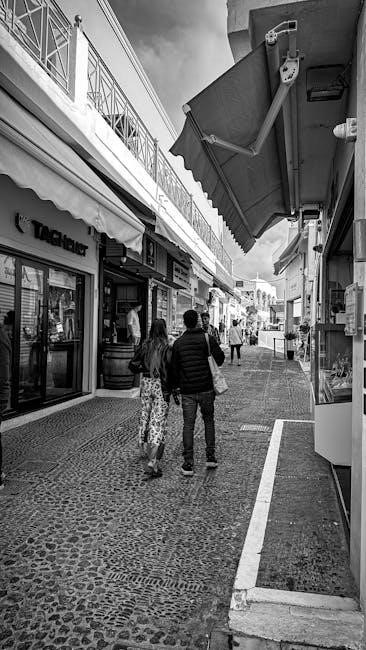Ray Bradbury’s The Pedestrian is a haunting dystopian short story exploring themes of technology, isolation, and conformity. The PDF version highlights Leonard Mead’s solitary walks in a futuristic city, emphasizing his rebellion against a society consumed by television and technological dominance. Bradbury’s vivid imagery and poetic language paint a chilling vision of a world where individuality is suppressed, offering a timeless warning about the dangers of unchecked technological advancement.
Overview of the Short Story
The Pedestrian by Ray Bradbury is a dystopian tale set in a futuristic city where television and technology dominate society. The story follows Leonard Mead, a man who defies societal norms by walking for pleasure in a world where such behavior is deemed peculiar. His solitary evening strolls lead to an encounter with a police car, highlighting the tension between individuality and conformity. Bradbury’s vivid imagery and poetic prose explore themes of isolation, rebellion, and the dehumanizing effects of technological advancement, offering a chilling critique of modern society.
Author Background: Ray Bradbury
Ray Bradbury (1920-2012) was a celebrated American author renowned for his fantasy and science fiction works. His writing often blended vivid imagination with poetic language, as seen in classics like Fahrenheit 451 and The Martian Chronicles. Bradbury’s storytelling explored themes of technology, humanity, and societal trends. A passionate walker himself, Bradbury drew inspiration from his own experiences, reflecting his love for simplicity and critique of modernity. His unique style and thought-provoking narratives have left a lasting impact on literature and popular culture.
Plot Summary
In a dystopian 2053, Leonard Mead’s evening walks make him an outcast in a tech-dominated society. A police car disrupts his stroll, questioning his defiance of conformity.
Setting: The Dystopian City of 2053
The story unfolds in a bleak, futuristic city where technology dominates and human interaction is scarce. The year is 2053, and the metropolis is characterized by its emptiness and silence. The once vibrant streets are now devoid of life, with only the occasional glow of television screens flickering behind closed windows. The sidewalks are cracked, and the atmosphere is eerily isolating, reflecting a society that has abandoned the simple joys of walking and human connection. This backdrop underscores Bradbury’s critique of a world consumed by technological advancement.
Protagonist: Leonard Mead and His Love for Walking
Leonard Mead is a man who defies societal norms by embracing the simple act of walking in a world dominated by technology. His nightly strolls through the desolate city streets reflect his deep connection to the physical world and his rejection of the sedentary, screen-focused lifestyle. Mead’s love for walking is not just a hobby but a form of rebellion, showcasing his individuality in a society that values conformity. His quiet defiance highlights the tension between tradition and progress in Bradbury’s dystopian vision.
The Encounter with the Police Car
The encounter with the police car marks a turning point in Leonard Mead’s story, as his solitary walk attracts the attention of an automated law enforcement vehicle. The police car, symbolizing societal control, questions Mead’s unusual behavior, revealing the oppressive nature of the dystopian world. Mead’s inability to provide a conventional reason for walking highlights the societal expectation of conformity. The interaction ultimately leads to his detention, emphasizing the consequences of deviating from normative behavior in a technology-driven society that values uniformity above individuality.

Themes and Symbolism
Ray Bradbury’s The Pedestrian explores themes of technology, isolation, and conformity through the symbolic decay of human interaction in a dystopian society dominated by screens and automation.
Technology and Its Impact on Society
In The Pedestrian, Ray Bradbury portrays a dystopian society where technology has eroded human connection. The city’s emptiness and silence reflect a world dominated by screens, as people prioritize television over real-life interactions. Leonard Mead’s solitary walks symbolize resistance against this technological takeover, where individuality is stifled. The police car’s presence underscores societal control, highlighting how technology enforces conformity. Bradbury warns of a future where humanity is lost to the glow of screens, emphasizing the need to preserve human interaction in a world increasingly governed by machines.
Isolation and Loneliness in a Futuristic World
In The Pedestrian, Bradbury captures a chilling future where isolation prevails. Leonard Mead’s evening walks reveal a desolate city, with dark windows and silent streets symbolizing a society disconnected from human interaction. The absence of others underscores the emotional loneliness of a world dominated by technology and television. Mead’s solitary journey reflects the broader societal alienation, where individuals are isolated even among millions, highlighting the cost of progress and the erosion of genuine human connection in a technologically driven world.
Conformity vs. Individuality
In The Pedestrian, Bradbury explores the tension between societal conformity and individuality. The story portrays a future where people are absorbed by television and technology, leaving no room for personal freedom. Leonard Mead’s act of walking becomes a symbol of rebellion against this conformity. His encounter with the police car highlights the societal expectation to align with technological norms, while Mead’s defiance underscores the importance of preserving individuality in a world that enforces uniformity. Bradbury’s narrative vividly contrasts the oppressive silence of conformity with the quiet strength of Mead’s lone resistance.

Character Analysis
Leonard Mead, the rebel pedestrian, embodies individuality in a conformist society. The automated police car symbolizes oppressive control, highlighting the clash between freedom and technological dominance.
Leonard Mead: The Rebel Pedestrian
Leonard Mead is a solitary figure who defies societal norms by walking in a futuristic city where technology dominates. His nocturnal strolls through empty streets symbolize his rebellion against a conformist world. Mead’s love for walking reflects his desire for freedom and individuality in a society that values television and technological advancement over personal autonomy. His encounter with the police car highlights the tension between his rebellious nature and the oppressive forces of conformity, making him a powerful symbol of resistance.
The Role of the Police Car and Its Significance
The police car in The Pedestrian embodies the oppressive authority of a dystopian society that enforces conformity. Its presence highlights the surveillance and control exerted over individuals, criminalizing actions that deviate from societal norms. The car’s encounter with Leonard Mead symbolizes the clash between individuality and a technology-driven world, reinforcing the theme of a society that values uniformity over personal freedom. The police car serves as a tool of intimidation, illustrating the dangers of unchecked technological advancement and societal control.

Style and Literary Devices
Bradbury’s vivid imagery and poetic style create a haunting atmosphere, while his use of silence and empty spaces symbolizes societal emptiness and isolation.
Bradbury’s Use of Imagery and Descriptive Language
Bradbury masterfully employs vivid imagery to paint a stark, eerie portrait of a futuristic city. Descriptions like “buckling concrete walk” and “frosty air” evoke a sense of desolation. His poetic language, such as “silence that was the city” and “shadow moving like the shadow of a hawk,” immerses readers in Leonard Mead’s solitary world. These techniques emphasize the themes of isolation and societal emptiness, while also highlighting Mead’s unique connection to his environment amidst a technologically dominated landscape.

The Importance of Silence and Empty Spaces
Bradbury emphasizes silence and empty spaces to underscore the story’s themes of isolation and societal detachment. The city’s eerie quiet and desolate streets symbolize a world devoid of human interaction, where technology has consumed lives. Leonard Mead’s walks through these empty spaces highlight his rebellion against this norm, as he finds solace in solitude. The silence serves as a stark contrast to the noise of technology, illustrating the loss of genuine human connection in a futuristic society.
Reception and Legacy
The Pedestrian has left a lasting impact on dystopian literature, influencing works that explore technology’s societal effects. Its themes resonate timeless warnings about conformity and isolation.
Impact of “The Pedestrian” on Dystopian Literature
Ray Bradbury’s The Pedestrian has significantly influenced dystopian literature, offering a cautionary tale about societal conformity and technological dominance. Its exploration of isolation and individuality resonates deeply, inspiring authors to examine similar themes. The story’s depiction of a world where walking is an act of rebellion has become a cornerstone in discussions about technology’s impact on human behavior. Bradbury’s vision continues to shape the genre, providing a timeless warning about the risks of a society governed by technology and mass media.
Comparisons with Other Bradbury Works
Ray Bradbury’s The Pedestrian shares themes of technology, isolation, and individuality with his other works, such as Fahrenheit 451 and The Martian Chronicles. Like these stories, it critiques societal conformity and explores the tension between progress and human connection. Bradbury’s poetic prose and vivid imagery are consistent across his works, creating a sense of nostalgia and caution. While each story stands alone, they collectively reflect Bradbury’s vision of humanity navigating futuristic worlds, emphasizing the enduring relevance of his warnings about technology’s impact on society.
Ray Bradbury’s The Pedestrian delivers a timeless warning about technology’s dominance and societal isolation, highlighting the importance of individuality in a conformist world.
The Timeless Message of “The Pedestrian”
Ray Bradbury’s The Pedestrian delivers a powerful warning about a society dominated by technology and media, where individuality is stifled. Leonard Mead’s simple act of walking becomes a rebellion against conformity, highlighting the loss of human connection in a futuristic world. Bradbury’s vision remains eerily relevant, urging readers to reflect on the importance of autonomy and the dangers of a society that values sameness over creativity and freedom. The story’s enduring message reminds us to cherish our unique voices in an increasingly homogenized world.
Final Thoughts on Bradbury’s Vision of the Future
Bradbury’s vision of the future in The Pedestrian is a cautionary tale about the dangers of unchecked technological advancement and societal conformity. His depiction of a world where individuality is suppressed and human connection is lost resonates deeply. The story serves as a stark reminder to cherish freedom, creativity, and the simple joys of life, urging readers to resist the pull of a homogenized, technology-driven society that values sameness over uniqueness.
